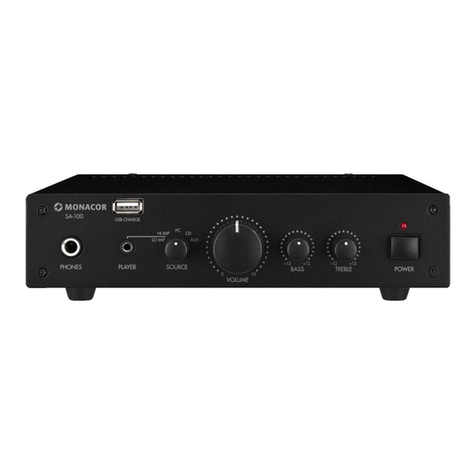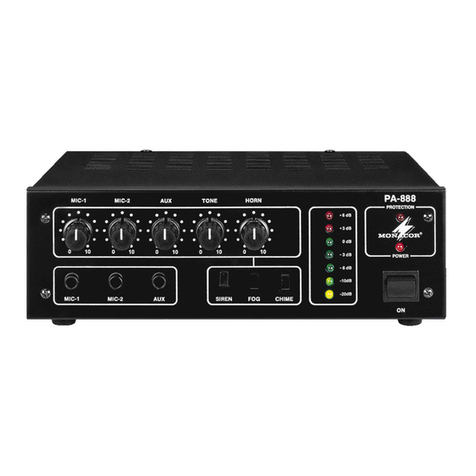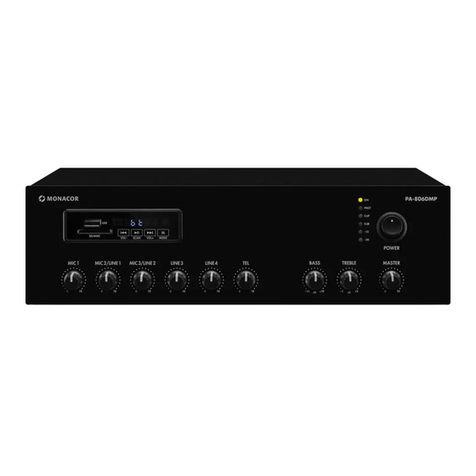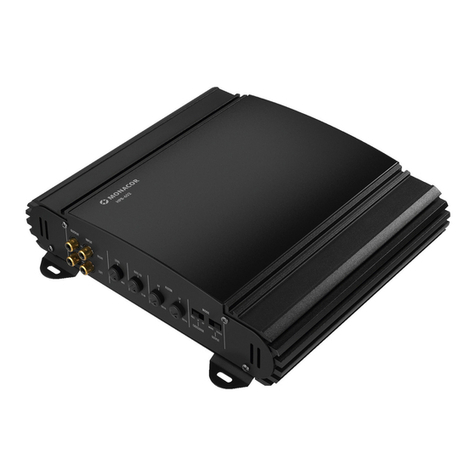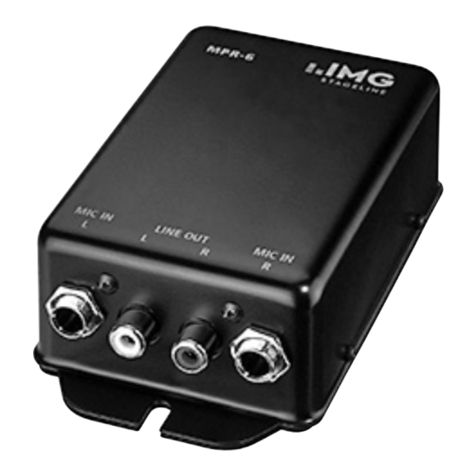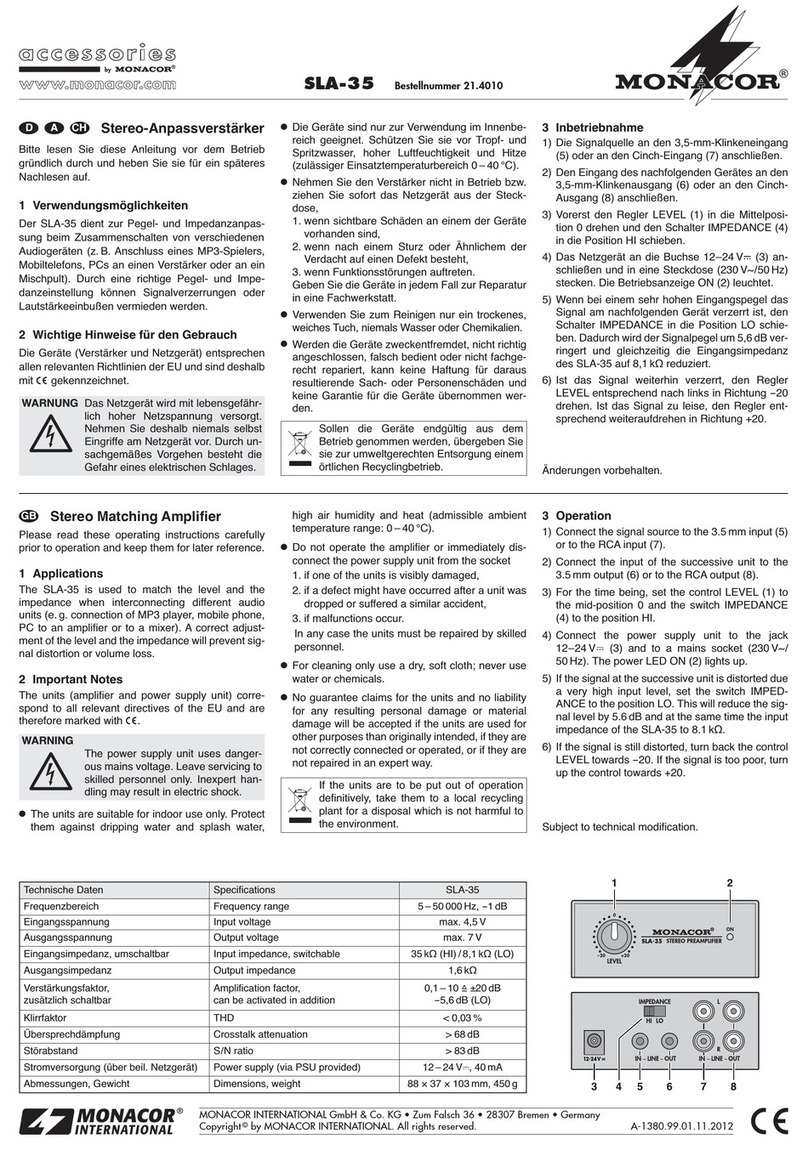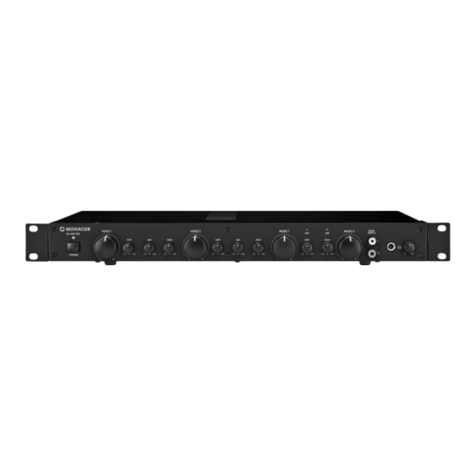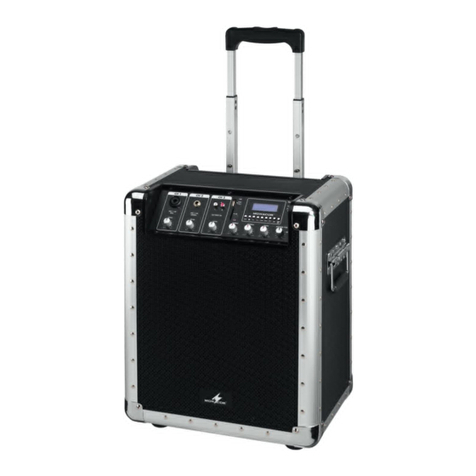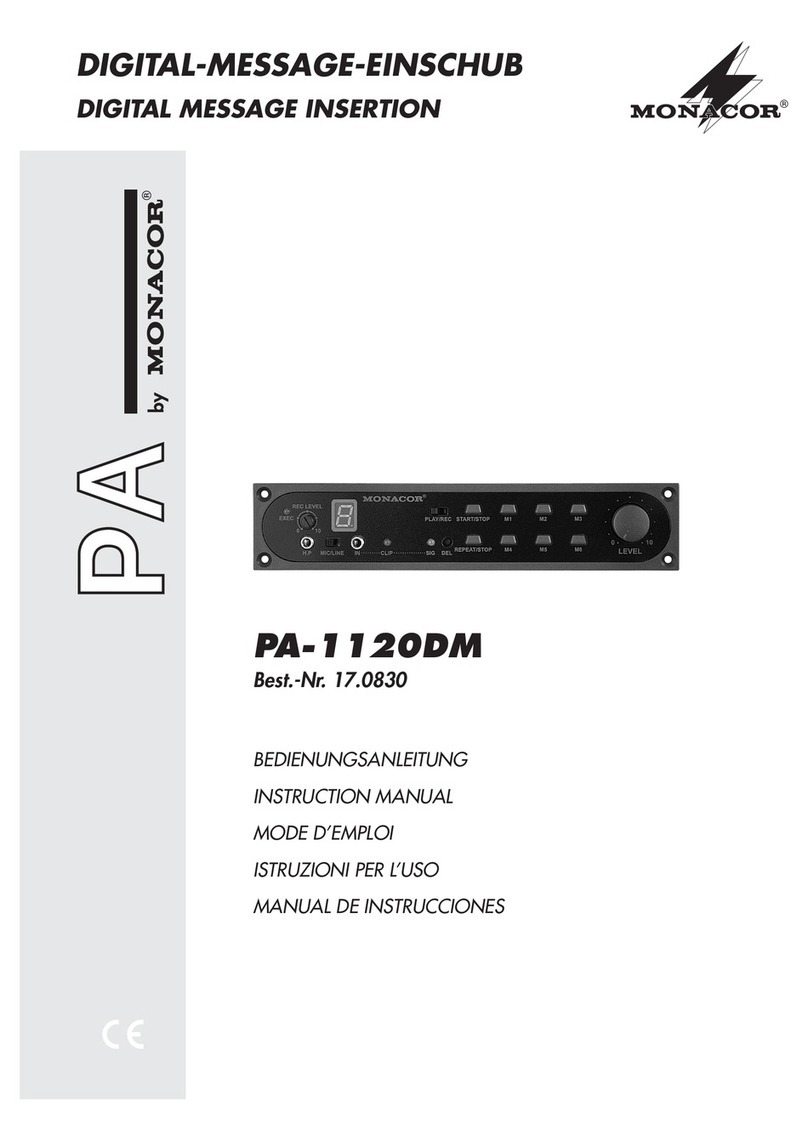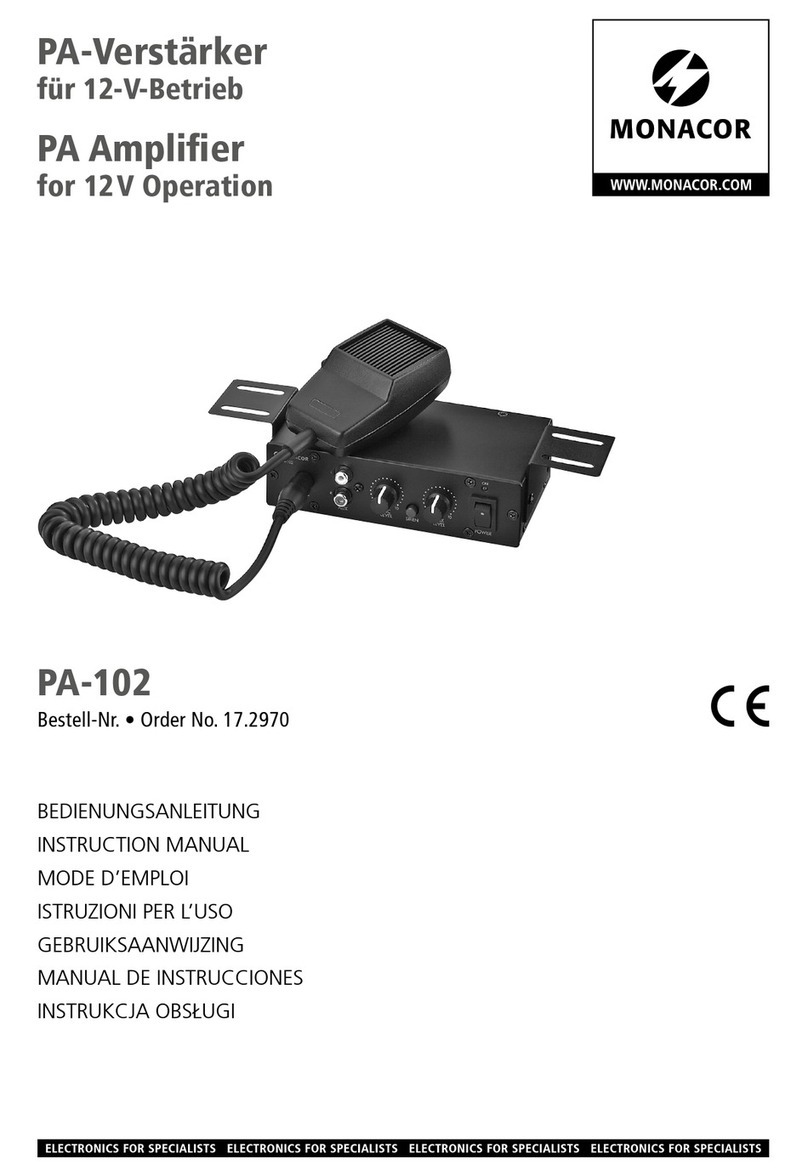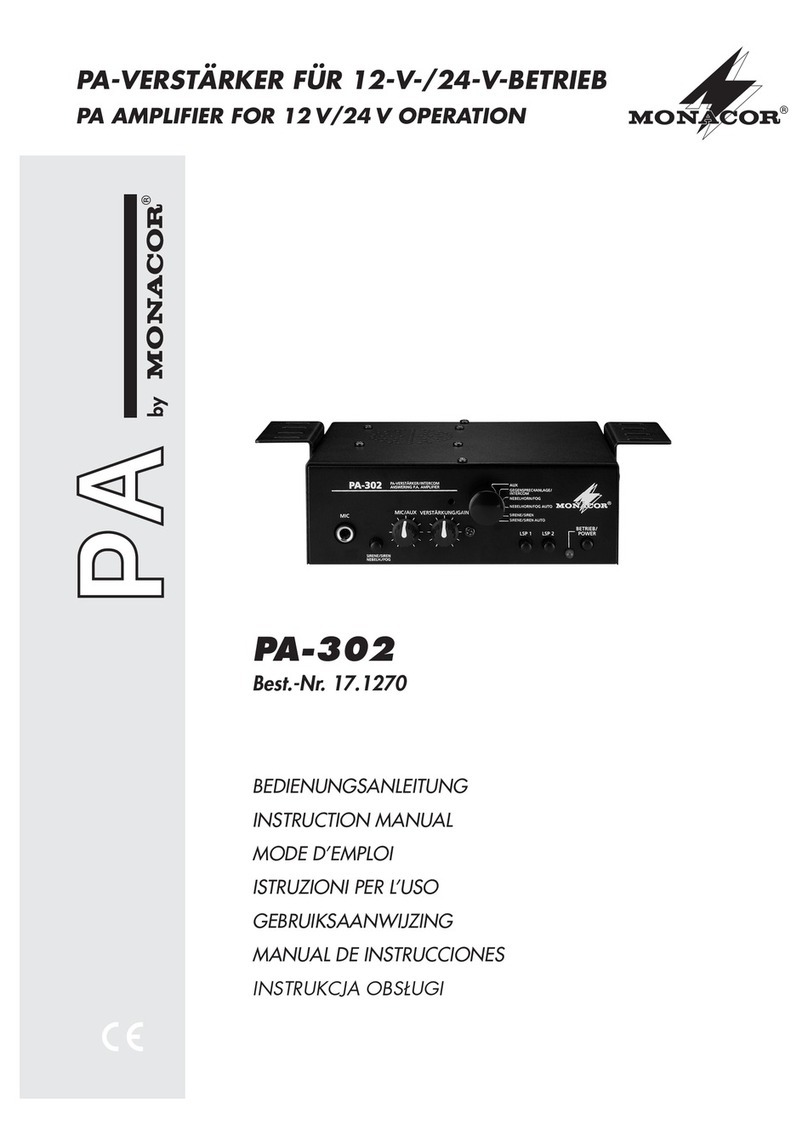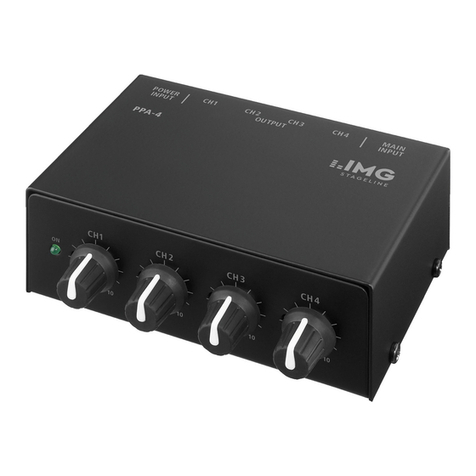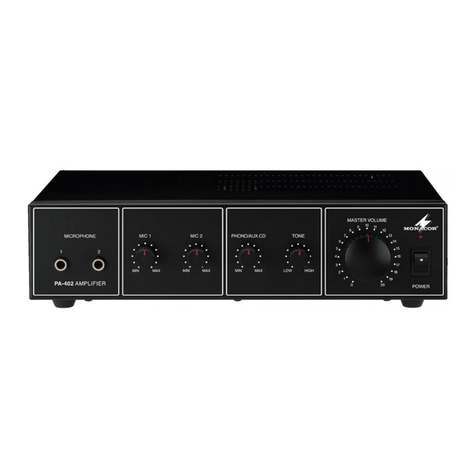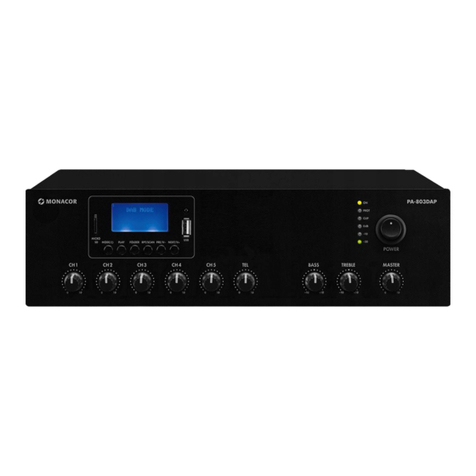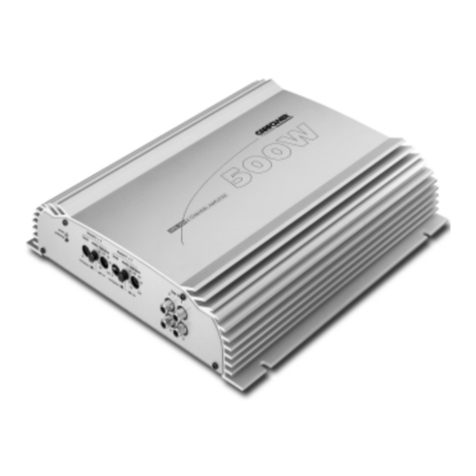POWER (13) nicht ausschalten. Es wird lediglich zwi-
schen Netz- und Notstromversorgung umgeschaltet.
Zum Schluß den Stecker des Netzkabels (17) in
eine Steckdose (230V~/50Hz) stecken.
6 Bedienung
Zur Vermeidung von Rückkopplungspfeifen und
Schaltgeräuschen den PA-1410MX bis zum Be-
dienschritt 5) ausgeschaltet lassen.
1) Alle Pegelregler LEVEL (1+4) und die beiden
Ausgangsregler (11) in die Position “0” stellen.
2) Für die Kanäle 1 bis 3 den Vorrang aktivieren
bzw. deaktivieren:
Kanal 1 über die Buchse P.T.T 1 (21) bzw. direkt
am angeschlossenen PTT-Mikrofon
Kanal 2 und 3 mit den Schaltern PRIORITY (8). In
der unteren Position ON ist der Vorrang aktiviert.
3) Für jeden Kanal separat mit dem Schiebeschal-
ter OUTPUT (5) wählen, auf welchen Ausgang,
d.h. auf welche Beschallungszone der jeweilige
Kanal geschaltet werden soll:
Ausgang 1, 1+2 oder 2.
4) Für die Kanäle 2 bis 10 jeweils mit dem Schalter
MODE (7) einstellen, welches Gerät angeschlos-
sen ist:
MIC : für Mikrofone, Low-Cut-Filter ein
MIC : für Mikrofone, Low-Cut-Filter aus
LINE: für Audiogeräte mit Line-Ausgang
(CD-Spieler, Tape-Deck, Tuner etc.)
Ist das Low-Cut-Filter (300-Hz-Hochpaß) einge-
schaltet, werden tieffrequente Geräusche unter-
drückt und Sprache wird verständlicher.
Bei den Kanälen 7 bis 10 läßt sich mit dem
Schalter MODE außerdem jeweils zwischen
einem Mikrofon am XLR-Anschluß (15) und einem
Gerät an den Cinch-Buchsen (20) umschalten.
5) Den PA-1410MX mit der Taste POWER (13) ein-
schalten. Die rote Betriebsanzeige über der Taste
leuchtet. Die ELA-Anlage komplett einschalten.
Ist eine Notstromversorgung angeschlossen,
leuchtet die Betriebsanzeige ständig, und der
Vorverstärker ist immer in Betrieb. Mit der Taste
POWER läßt sich dann lediglich zwischen Netz-
versorgung und Notstromversorgung umschal-
ten. Für den normalen Betrieb mit der Taste
POWER auf Netzversorgung schalten. Bei einem
Stromnetzausfall schaltet der Vorverstärker dann
automatisch auf die Notstromversorgung um.
6) Die beiden Ausgangsregler (11) in die Position
“7” stellen. Die Lautstärke der angeschlossenen
Mikrofone und Audiogeräte mit den jeweiligen
Reglern LEVEL (4) einstellen. Für alle nicht be-
nutzten Kanäle die Regler auf „0“ stehen lassen.
7) Den Klang für die beiden Ausgänge jeweils
getrennt mit den Reglern LOW (9) für die Bässe
und HIGH (10) für die Höhen einstellen.
8) Zum Schluß mit den beiden Reglern (11) die Aus-
gänge optimal aussteuern. Bei den lautesten
Passagen sollte die grüne LED „0“ der Pegelan-
zeige (12) aufleuchten. Bei Übersteuerung leuch-
tet die rote LED „+3“. Dann die Lautstärke mit
dem entsprechenden Regler reduzieren.
6.1 Gong
1) Den Gong mit dem Schiebeschalter OUTPUT (2)
auf den Ausgang 1, 1+2 oder 2 schalten.
2) Vor einer Durchsage läßt sich der Gong mit der
Taste (3) oder mit einem zusätzlich ange-
schlossenen Taster (Anschlüsse 22) aktivieren.
Während des Gongs werden die Kanäle 4–10
stummgeschaltet, die auf dem gleichen Ausgang
wie der Gong liegen.
3) Die Gonglautstärke mit dem Regler LEVEL (1)
einstellen.
4) Der Gong kann zwischen einer 2- und 4-Tonfolge
umschaltet werden. Dieses darf jedoch nur durch
eine qualifizierte Fachkraft erfolgen, weil dazu
das Gerät geöffnet werden muß.
Zuerst unbedingt den Netzstecker aus der
Steckdose ziehen. Den Gehäusedeckel ab-
schrauben. Mit der Steckbrücke MS102 an der
linken Kante der Leiterplatte die Tonfolge ändern.
Das Gehäuse wieder verschließen.
6.2 ELA-PTT-Mikrofon PA-1120PTT
(als separates Zubehör erhältlich)
Die hier angegebenen Bedienelemente befinden
sich am PA-1120PTT.
1) Soll beim Betätigen der Sprechtaste TALK vor
einer Durchsage der Gong ertönen, den Schalter
CHIME auf der Rückseite in die Position ON
(nach unten) stellen.
2) Soll das Mikrofon Vorrang vor den Kanälen 4 bis
10 erhalten, den Schalter PRIORITY in die Posi-
tion ON stellen.
3) Für eine Durchsage die Sprechtaste TALK ge-
drückt halten, und ggf. den Gong abwarten.
7 Technische Daten
Eingänge (Empfindlichkeit/Impedanz)
Mic XLR: . . . . . . . . . . . . 2,5mV/5kΩ, sym.
Line XLR: . . . . . . . . . . . 250mV/5kΩ, sym.
Line Cinch: . . . . . . . . . . 250mV/10kΩ, asym.
Ausgänge (max. Pegel/Impedanz)
Output 1, Output 2: . . . . 1,2V/200Ω, XLR sym.
Rec: . . . . . . . . . . . . . . . 0,775V/10kΩ,
Cinch asym.
Frequenzbereich: . . . . . . . 20–20000Hz,
-
0,5dB
Klirrfaktor: . . . . . . . . . . . . < 0,05%
Signal/Rauschabstand
Mic: . . . . . . . . . . . . . . . . > 60dB
Line: . . . . . . . . . . . . . . . > 75dB
Kanaltrennung
Mic: . . . . . . . . . . . . . . . . > 60dB
Line: . . . . . . . . . . . . . . . > 75dB
Einsatztemperatur: . . . . . 0–40°C
Stromversorgung
Netzspannung: . . . . . . . 230V~/50Hz
Leistungsaufnahme: . . . 12VA
Notstromversorgung: . . 24V
Gleichstromaufnahme: . 0,5A
Abmessungen (BxHxT): 482x44x250mm, 1HE
Gewicht: . . . . . . . . . . . . . . 3,5kg
Laut Angaben des Herstellers.
Änderungen vorbehalten.
Note: with connected emergency power supply the
preamplifier cannot be switched off with the POWER
switch (13). It is only switched between mains sup-
ply and emergency power supply.
Finally connect the plug of the mains cable (17) to a
mains socket (230V~/50Hz).
6 Operation
To avoid howling and switching noise, leave the PA-
1410MX switched off up to operating step 5).
1) Set all LEVEL controls (1+4) and the two output
controls (11) to position “0”.
2) For the channels 1 to 3 activate or deactivate the
priority:
channel 1 viathe jack P.T.T1(21) or directly on the
connected PTT microphone
channels 2 and 3 with the switches PRIORITY (8).
In the lower position ON the priority is activated.
3) With the sliding switch OUTPUT (5) select sepa-
rately for each channel to which output, i.e. to
which PA zone, the respective channel is to be
switched: output 1, 1+2, or 2.
4) For the channels 2 to 10 adjust in each case with
the MODE switch (7) which unit is connected:
MIC : for microphones, low cut filter on
MIC : for microphones, low cut filter off
LINE: for audio units with line output (CD
player, tape deck, tuner, etc.)
If the low cut filter (300Hz high pass) is switched
on, low frequency noise is suppressed and
speech becomes easier to understand.
In addition, for channels 7 to 10 it is possible to
switch with the MODE switch in each case be-
tween a microphone connected to the XLR jack
(15) and a unit connected to the phono jacks (20).
5) Switch on the PA-1410MX with the POWER
switch (13). The red operating indication above
the button lights up. Switch on the PA system
completely.
If an emergency power supply is connected,
the operating indication lights continuously, and
the preamplifier is always in operation. Then it is
only possible to switch between mains supply
and emergency power supply with the POWER
switch. For normal operation switch with the
POWER switch to mains supply. Then, in case of
a mains failure, the preamplifier switches auto-
matically to emergency power supply.
6) Set the two output controls (11) to position “7”.
Adjust the volume of the connected microphones
and audio units with the respective LEVEL con-
trols (4). Leave the controls in “0” position for all
channels not used.
7) Adjust the sound for the two outputs separately
with the controls LOW (9) for the bass frequen-
cies and HIGH (10) for the high frequencies.
8) Finally control the outputs in an optimum way
with the two controls (11). With music peaks the
green LED “0” of the level indication (12) should
light up. In case of overload the red LED “+3”
lights up. Then reduce the volume with the corre-
sponding control.
6.1 Chime
1) Set the chime with the sliding switch OUTPUT (2)
to the output 1, 1+2, or 2.
2) Prior to an announcement the chime can be
activated with the button (3) or with an addition-
ally connected momentary push-button (terminals
22). While the chime is activated, the channels 4
to 10 are muted which are on the same output as
the chime.
3) Adjust the chime volume with the LEVEL control
(1).
4) The chime can be switched between a 2-audio
sequence and 4-audio sequence. However, this
must only be made by a qualified technician
because for this purpose the unit must be opened.
First disconnect the mains plug from the
mains socket in any case. Screw off the housing
cover. Change the audio sequence with the
jumper MS102 at the left edge of the PCB. Close
the housing again.
6.2 PA PTT microphone PA-1120PTT
(available as separate accessory)
The operating elements indicated here are located
on the PA-1120PTT.
1) For the chime to sound prior to an announcement
when activating the TALK button, set the CHIME
switch on the rear side to position ON (down-
wards).
2) For the priority of the microphone to the channels
4 to 10, set the PRIORITY switch to position ON.
3) For an announcement keep the TALK button
pressed, and if necessary, wait for the chime.
7 Specifications
Inputs (sensitivity/impedance)
Mic XLR: . . . . . . . . . . . . 2.5mV/5kΩ, bal.
Line XLR: . . . . . . . . . . . 250mV/5kΩ, bal.
Line phono: . . . . . . . . . 250mV/10kΩ, unbal.
Outputs (max. level/impedance)
output 1, output 2 . . . . . 1.2V/200Ω, XLR bal.
Rec: . . . . . . . . . . . . . . . 0.775V/10kΩ, phono
unbal.
Frequency range: . . . . . . 20–20000 Hz,
-
0.5dB
THD: . . . . . . . . . . . . . . . . < 0.05%
S/N ratio
Mic: . . . . . . . . . . . . . . . . > 60dB
Line: . . . . . . . . . . . . . . . > 75dB
Channel separation
Mic: . . . . . . . . . . . . . . . . > 60dB
Line: . . . . . . . . . . . . . . . > 75dB
Ambient temperature: . . . 0–40°C
Power supply
mains voltage: . . . . . . . 230V~/50Hz
power consumption: . . . 12VA
emergency power
supply: . . . . . . . . . . . . . 24V
DC consumption: . . . . . 0.5A
Dimensions (W x H x D): . 482 x 44 x 250mm,
1 rack space
Weight: . . . . . . . . . . . . . . . 3.5kg
According to the manufacturer.
Subject to change.
6
GB
D
A
CH
